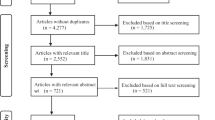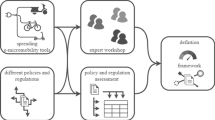Abstract
Electric micromobility is a promising part of the transition towards more sustainable and ecologic transportation systems – especially as a complement to public transportation on the last mile. However, so far adoption of such services is still not ideal, especially in rural areas. By means of a quantitative study with 137 users, our work-in-progress paper investigates user acceptance in urban and rural areas. Based on a structural equation model, our research shows that rural municipalities and providers should especially consider aspects that address the performance expectation and the perceived collective environmental impact of potential users, as these have been found to be especially relevant for the intention to use. Our study thus contributes to the theoretical understanding of e-micromobility, which has so far been mostly investigated in urban areas.
Access this chapter
Tax calculation will be finalised at checkout
Purchases are for personal use only
Similar content being viewed by others
References
Abduljabbar, R.L., Liyanage, S., Dia, H.: The role of micro-mobility in shaping sustainable cities: a systematic literature review. Transp. Res. Part D: Transp. Environ. 92, 102734 (2021)
Bennett, C., Ackerman, E., Fan, B., Bigham, J., Carrington, P., Fox, S.: Accessibility and the crowded sidewalk: Micromobility’s impact on public space. In: Designing Interactive Systems Conference 2021, pp. 365–380 (2021)
Berg, J., Ihlström, J.: The importance of public transport for mobility and everyday activities among rural residents. Soc. Sci. 8(2), 58 (2019)
Bieliński, T., Ważna, A.: Electric scooter sharing and bike sharing user behaviour and characteristics. Sustainability 12(22), 9640 (2020)
Buchenrieder, G., Dufhues, T., Möllers, J., Runschke, D., Sagyndykova, G.: Return to the countryside: the return intentions of highly educated young people in the Akmola province of northern Kazakhstan. Popul. Space Place 26(2), e2273 (2020)
Davis, F.D.: Perceived usefulness, perceived ease of use, and user acceptance of information technology. MIS Q. 13(3), 319–340 (1989)
Dean, M.D., Zuniga-Garcia, N.: Shared e-scooter trajectory analysis during the COVID-19 pandemic in Austin, Texas. Transp. Res. Rec. 2677(4), 432–447 (2023)
Dodds, W.B., Monroe, K.B., Grewal, D.: Effects of price, brand, and store information on buyers product evaluations. J. Mark. Res. 28(3), 307–319 (1991)
Eisenmann, C., Köhler, K., Schulz, A., Seiffert, I., Gaus, D., Link, H.: Verkehr in zahlen 2022/2023 (2022)
Fearnley, N., Johnsson, E., Berge, S.H.: Patterns of E-Scooter use in Combination with Public Transport. Findings (2020)
Hair, J., Hult, G.T.M., Ringle, C.M., Sarstedt, M.: A Primer on Partial Least Squares Structural Equation Modeling (PLS-SEM), 2nd edn. SAGE Publications, Thousand Oaks, CA (2016). May
Hair, J.F., Ringle, C.M., Sarstedt, M.: PLS-SEM: Indeed a silver bullet. J. Mark. Theor. Pract. 19(2), 139–152 (2011)
Henseler, J., Ringle, C.M., Sinkovics, R.R.: The use of partial least squares path modeling in international marketing. In: New challenges to international marketing. Emerald Group Publishing Limited (2009)
Huang, F.H.: User behavioral intentions toward a scooter-sharing service: an empirical study. Sustainability 13(23), 13153 (2021)
Kappagantu, A., Yaremchuk, K., Tam, S.: Head and neck injuries and electronic scooter use in the united states. Laryngoscope 131(11), E2784–E2789 (2021)
Kåresdotter, E., Page, J., Mörtberg, U., Näsström, H., Kalantari, Z.: First mile/last mile problems in smart and sustainable cities: a case study in Stockholm county. J. Urban Technol. 29(2), 115–137 (2022)
Karlı, R.G.Ö., Çelikyay, S.: Current trends in smart cities: shared micromobility. In: Ben Ahmed, M., Boudhir, A.A., Karas, I.R., Jain, V., Mellouli, S. (eds.) SCA 2021. LNNS, vol. 393, pp. 187–198. Springer, Cham (2022). https://doi.org/10.1007/978-3-030-94191-8_15
Kauschke, L.: Akzeptanzstudie Smart Mobility. htw saar Forschungsgruppe Verkehrstelematik (2020). https://kosmos-project.eu/wp-content/uploads/2020/05/Akzeptanzstudie-Smart-Mobility_2.pdf
Kopplin, C.S., Brand, B.M., Reichenberger, Y.: Consumer acceptance of shared E-scooters for urban and short-distance mobility. Transp. Res. Part D: Transp. Environ. 91, 102680 (2021)
Krier, C., Chrétien, J., Lagadic, M., Louvet, N.: How do shared Dockless E-scooter services affect mobility practices in Paris? A survey-based estimation of modal shift. Transp. Res. Rec. 2675(11), 291–304 (2021)
Kriswardhana, W., Esztergár-Kiss, D.: Exploring the aspects of MaaS adoption based on college students preferences. Transp. Policy 136, 113–125 (2023)
Laa, B., Leth, U.: Survey of E-scooter users in Vienna: who they are and how they ride. J. Transp. Geogr. 89, 102874 (2020)
Lawo, D., Böhm, L., Flügge, A.K., Pakusch, C., Stevens, G.: Going car-free: investigating mobility practice transformations and the role of ICT. In: Proceedings of the 5th International Conference on Computer-Human Interaction Research and Applications (CHIRA 2021), October 28-29, 2021, pp. 36–47. SciTePress, Science and Technology Publications (2021)
Matviienko, A., et al.: E-scootar: exploring unimodal warnings for E-scooter riders in augmented reality. In: CHI Conference on Human Factors in Computing Systems Extended Abstracts, pp. 1–7 (2022)
Meurer, J., Lawo, D., Pakusch, C., Tolmie, P., Wulf, V.: Opportunities for sustainable mobility: re-thinking eco-feedback from a citizen’s perspective. In: Proceedings of the 9th International Conference on Communities & Technologies-Transforming Communities, pp. 102–113 (2019)
Nigro, M., et al.: Investigating potential electric micromobility demand in the city of Rome, Italy. Transp. Res. Procedia 62, 401–407 (2022)
Nisson, P.L., Ley, E., Chu, R.: Electric scooters: case reports indicate a growing public health concern (2020)
Oeschger, G., Carroll, P., Caulfield, B.: Micromobility and public transport integration: the current state of knowledge. Transp. Res. Part D: Transp. Environ. 89, 102628 (2020)
Oswalt, P., Meyer, L., Rettich, S., Böker, F., Roost, F., Jeckel, E.: Bauen für die neue mobilität im ländlichen raum: Anpassung der baulichen strukturen von dörfern und kleinstädten im zuge der digitalisierung des verkehrs (2021)
Öztaş Karlı, R.G., Karlı, H., Çelikyay, H.S.: Investigating the acceptance of shared E-scooters: empirical evidence from turkey. Case Stud. Transp. Policy 10(2), 1058–1068 (2022)
Pimentel, R.W., Lowry, M.B., Consortium, P.N.T., et al.: If you provide, will they ride? motivators and deterrents to shared micro-mobility. Tech. rep., Pacific Northwest Transportation Consortium (PacTrans)(UTC) (2020)
Polites, G.L.: The duality of habit in information technology acceptance. Ph.D. thesis, University of Georgia (2009)
Putri, B.A.I., Atha, F., Rizka, F., Amalia, R., Husna, S.: Factors affecting E-scooter sharing purchase intention: an analysis using unified theory of acceptance and use of technology 2 (UTAUT2). Int. J. Creative Bus. Manag. 1(2), 58–73 (2021)
Quadrifoglio, L., Chandra, S., et al.: Evaluating the Effect of Street Network Connectivity on First/Last Mile Transit Performance. Southwest Region University Transportation Center (US), Tech. rep. (2011)
Rammstedt, B.: Reliabilität, validität, objektivität. Handbuch der sozialwissenschaftlichen Datenanalyse, pp. 239–258 (2010)
Ringle, C.M., Wende, S., Becker, J.M.: Smartpls 4. oststeinbek: SmartPLS GmbH (2022)
Sarstedt, M., Ringle, C.M., Hair, J.F.: Partial least squares structural equation modeling. In: Homburg, C., Klarmann, M., Vomberg, A.E. (eds.) Handbook of Market Research. Springer, Cham (2021). https://doi.org/10.1007/978-3-319-05542-8_15-2
Schmidt, J.A., Hellali-Milani, S.: Herausforderung für die stadtplanung: Mobilität findet stadt–neue intermodale urbane mobilität mit neuen nutzer-und nutzungsansprüchen. Elektrofahrzeuge für die Städte von morgen: Interdisziplinärer Entwurf und Test im DesignStudio NRW, pp. 19–25 (2016)
Şengül, B., Mostofi, H.: Impacts of E-micromobility on the sustainability of urban Transportationa systematic review. Appl. Sci. 11(13), 5851 (2021)
Shmueli, G., Ray, S., Estrada, J.M.V., Chatla, S.B.: The elephant in the room: predictive performance of pls models. J. Bus. Res. 69(10), 4552–4564 (2016)
Shultz, K.S., Whitney, D.J., Zickar, M.J.: Measurement Theory in Action: Case Studies and Exercises. Routledge (2020)
Stocker, A., Shaheen, S.: Shared automated mobility: early exploration and potential impacts. In: Meyer, G., Beiker, S. (eds.) Road Vehicle Automation 4, pp. 125–139. Springer International Publishing, Cham (2018). https://doi.org/10.1007/978-3-319-60934-8_12
Stone, R.N., Winter, F.W.: Risk: is it still uncertainty times consequences. In: Proceedings of the American Marketing Association. vol. 1, pp. 261–265. Winter Educators Conference Chicago, IL (1987)
Tavakol, M., Dennick, R.: Making sense of Cronbach’s alpha. Int. J. Med. Educ. 2, 53–55 (2011). https://doi.org/10.5116/ijme.4dfb.8dfd
Thøgersen, J., Møller, B.: Breaking car use habits: the effectiveness of a free one-month travelcard. Transportation 35(3), 329–345 (2008). https://doi.org/10.1007/s11116-008-9160-1
Umweltbundesamt, U.: Umweltbelastungen durch verkehr. Link: https://www.umweltbundesamt.de/daten/verkehr/umweltbelastungen-durch-verkehr. Letzter Zugriff 28, 2022 (2022)
Vallat, R.: Pingouin: statistics in python. J. Open Source Softw. 3(31), 1026 (2018)
Venkatesh, V., Morris, M.G., Davis, G.B., Davis, F.D.: User acceptance of information technology: toward a unified view. MIS Q. 27(3), 425–478 (2003)
Venkatesh, V., Thong, J.Y., Xu, X.: Consumer acceptance and use of information technology: extending the unified theory of acceptance and use of technology. MIS Q. 36(1), 157–178 (2012)
Verplanken, B., Aarts, H.: Habit, attitude, and planned behaviour: is habit an empty construct or an interesting case of goal-directed automaticity? Eur. Rev. Soc. Psychol. 10(1), 101–134 (1999)
Zhang, Y., Kamargianni, M.: A review on the factors influencing the adoption of new mobility technologies and services: autonomous vehicle, drone, micromobility and mobility as a service. Transp. Rev. 43(3), 407–429 (2023)
Zijlstra, T., Durand, A., Hoogendoorn-Lanser, S., Harms, L.: Early adopters of mobility-as-a-service in the Netherlands. Transp. Policy 97, 197–209 (2020)
Author information
Authors and Affiliations
Corresponding author
Editor information
Editors and Affiliations
Rights and permissions
Copyright information
© 2023 The Author(s), under exclusive license to Springer Nature Switzerland AG
About this paper
Cite this paper
Neifer, T. et al. (2023). Understanding Adoption of Last Mile Electric Micromobility in Rural Areas: A Structural Equation Modeling Approach. In: da Silva, H.P., Cipresso, P. (eds) Computer-Human Interaction Research and Applications. CHIRA 2023. Communications in Computer and Information Science, vol 1997. Springer, Cham. https://doi.org/10.1007/978-3-031-49368-3_10
Download citation
DOI: https://doi.org/10.1007/978-3-031-49368-3_10
Published:
Publisher Name: Springer, Cham
Print ISBN: 978-3-031-49367-6
Online ISBN: 978-3-031-49368-3
eBook Packages: Computer ScienceComputer Science (R0)




